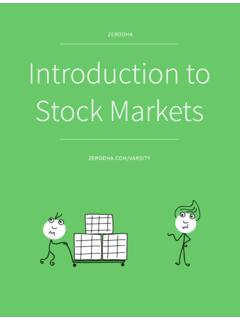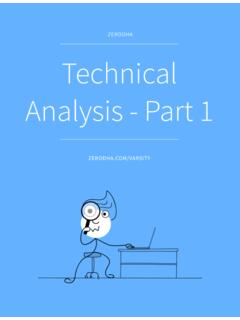Transcription of zerodha.com/varsity
1 TABLE OF CONTENTS. 1 Orientation 1. Setting the context 1. What should you know? 3. 2 Bull Call Spread 6. Background 6. Strategy notes 8. Strike selection 14. 3 Bull Put spread 22. Why Bull Put Spread? 22. Strategy notes 23. Other strike combinations 28. 4 Call ratio back spread 32. Background 32. Strategy notes 33. Strategy generalization 38. Welcome back the Greeks 39. 5 Bear call ladder 46. Background 46. Strategy notes 46. Strategy generalization 52. Effect of Greeks 54. 6 Synthetic long & arbitrage 57. Background 57. Strategy notes 58. The Fish market Arbitrage 62. The options arbitrage 65. 7 Bear put spread 70. Spreads versus naked positions 70. Strategy notes 71. Strategy critical levels 75. Quick notes on Delta 76.
2 Strike selection and effect of volatility 78. 8 Bear call spread 83. Choosing Calls over Puts 83. Strategy notes 84. Strategy generalization 88. Strike selection and impact of volatility 88. 9 Put ratio back spread 94. Background 94. Strategy notes 95. Strategy generalization 99. Delta, strike selection, and effect of volatility 100. 10 The long straddle 104. The directional dilemma 104. Long straddle 105. Volatility matters 109. What can go wrong with the straddle? 111. 11 The short straddle 113. Context 113. The short straddle 114. Case study 116. The Greeks 119. 12 The long & short straddle 121. Background 121. Strategy notes 122. Delta and Vega 128. Short strangle 129. 13 Max pain & PCR ratio 130.
3 My experience with option theory 130. Max pain theory 130. Max pain calculation 132. A few modifications 137. The put call ratio 138. Final thoughts 140. CHAPTER 1. Orientation Setting the context Before we start this module on Option Strategy, I would like to share with you a Behavioral Finance article I read couple of years ago. The article was titled Why winning is addictive . Here is the article, authored by (a regular columnist for HBL) . To buy and bet on a lottery ticket a game that you typically avoid because you understand the odds of winning the jackpot is really low. However, if you do win the ticket, you will be most likely tempted to buy a lottery ticket regularly thereafter! We exhibit similar behavior when it comes to our investments as well.
4 What drives such behavior? As humans, our life is governed by anticipation. So, looking forward to winning a lottery is exciting and so is realizing that expectation. Research in neuroscience has however shown that anticipating a win is more exciting than actual winning! Nevertheless, once you experience the excitement of winning a lottery you feel the need to indulge. That is, your brain compels you to buy a lottery ticket, even though you are aware of the odds of winning the second one. This happens because we tend to use more of reflexive brain than reflective brain. The reflective brain performs calculation that helps you analyze and think. The reflexive brain helps you feel and is more intuitive.
5 When you feel an urge to buy a lottery ticket, it is your reflexive brain that is pushing you to do so. Your reflective brain is likely to tell you that the odds of winning the jackpot for the second time are low! Now consider trading in equity options. You know that buying calls and puts has its risk, as options often expire worthless. Yet we may choose to buy them regularly, especially if we have already experienced large gains from such investments, for it is the reflexive brain in action. With trading options there is another factor at play. We know that 1. options carry the risk of losing capital when our view on the underlying stock or the index turns wrong. The fact that we can lose money makes our experience of winning against such odds even more exciting!
6 This is not so much true of lottery because a lottery is a game of chance while investments, we believe, require some degree of skill . You maybe be wondering, why I chose to post the above article right at the beginning of this module. Well, this article echoes some of my own thoughts; in fact it goes a step further to put things in the behavioral finance context. From the many interactions that I've have had with both experienced and aspiring options traders, one point is quite common - most options traders treat options trading as a hit or miss kind of a trade. There is always a sense of amusement when one initiates an option trade, many don't realize how fatal this na ve amusement can be. Traders buy options (month after month) with a hope they would double their investment.
7 Trading options with such a mindset is a perfect recipe for a P&L disaster. The bottom line is this if you aspire to trade options, you need to do it the right way and follow the right approach. Else you can be rest assured the gambling attitude will eventually consume your entire trading capital and you will end up having a short, self destructive option trading career. 2. I do have to mention this now - the common phrase that goes like this ( options). limited risk, unlimited profit potential is a silent P&L killer. Newbie traders are disillusioned by this theoretically correct' but practically disastrous fact and thereby end up blowing up their books, slowly and steadily. Hence I do believe that trading options blindly without a strategy is a dangerous but irresistible pass time (courtesy - Pink Floyd).
8 I don't intend to scare you with this note; I'm only trying to set the context here. With the previous module on Options Theory, I'm sure you would have realized that unlike other topics in the markets, the science involved in Options is heavy duty. It can be quite overwhelming, but you will have to trust me here the only way to understand and master options trading is by structuring your learning path with a good judicious mix of theory and practice. In this module, I will attempt to give you a good overview of what you really need to know about some of the popular options strategies. Like always, I will try and stick to the practical aspect and ignore the unwanted (and confusing) theory part. 3. As far as I'm aware, there are close to 475 options strategies out there in the public domain and I'm sure at least another 100 odd strategies are hidden in the proprietary books of brokers, bankers, and traders.
9 Given this should you know all these strategies put up in the public domain? Answer is a simple no. What should you know? You only need to know a handful of strategies but you need to know them really well. Once you know these strategies all you need to do is analyze the current state of markets (or the stock) and map it with the right option strategy from your strategy quiver. Keeping this in perspective we will discuss certain strategies. Bullish Strategies Bearish Spreads Neutral Strategies 1. Bull Call Spread 1. Bear Call Spread 1. Long & Short Straddles 2. Bull Put Spread 2. Bear Put Spread 2. Long & Short Strangles 3. Call Ratio Back Spread 3. Bull Put Ladder 3. Long & Short Iron 4. Bear Call Ladder 4.
10 Put Ratio Back spread Condor 5. Call Butterfly 5. Strip 4. Long & Short Butterfly 6. Synthetic Call 6. Synthetic Put 5. Box 7. Straps Besides discussing the above strategies I also intend to discuss . 1. Max Pain for option writing (some key observations and practical aspects). 2. Volatility Arbitrage employing Dynamic Delta hedging 4. The plan is to discuss one option strategy per chapter so that there is ample clarity about the strategy, without any mix up or confusion. This means to say we will have roughly about 20 chapters in this module, although I suppose each chapter would not be too lengthy. For each of the strategy I will discuss the background, implementation, payoff, breakeven, and perhaps the right strikes to use considering the time to expiry.
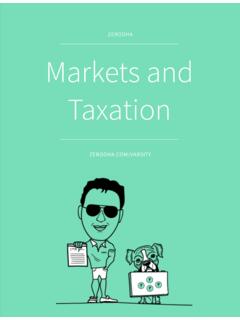




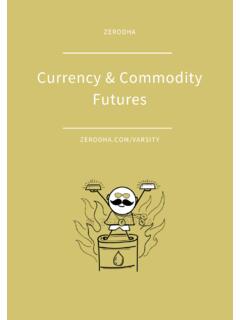
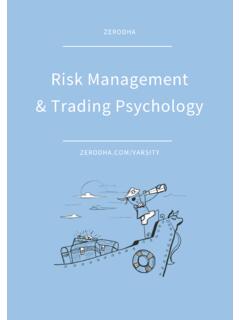





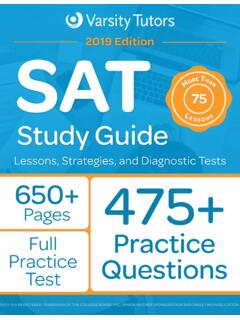
![VARSITY DATE EVENT ROUND OFFICIAL [ ] JV](/cache/preview/d/e/2/d/a/9/d/9/thumb-de2da9d900ba82e4c6ce0aada4e07df8.jpg)
